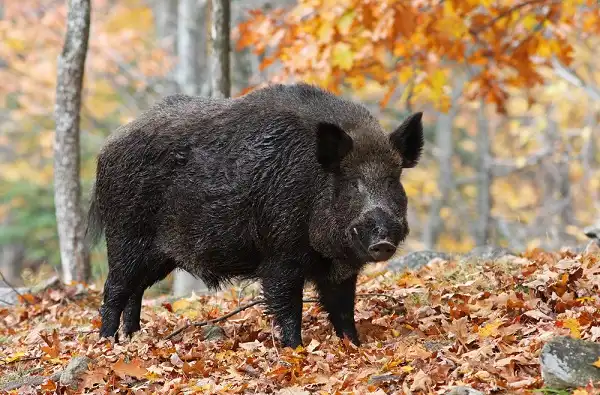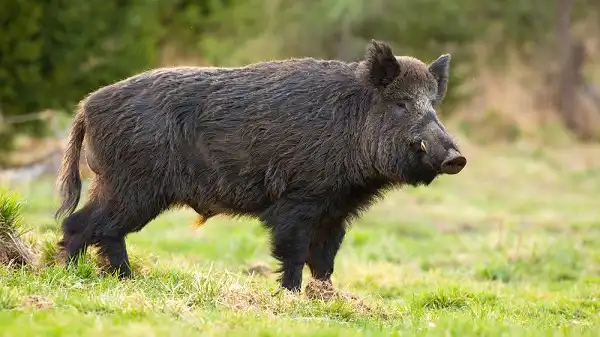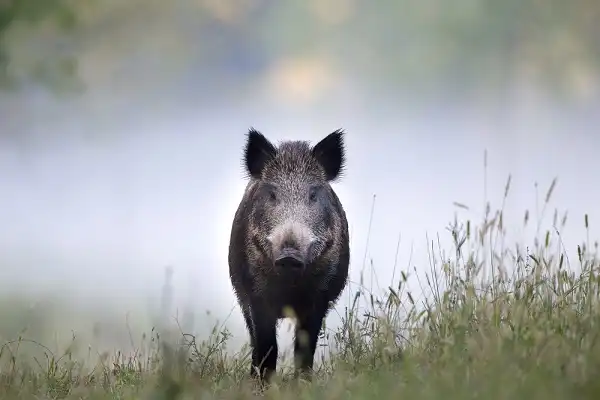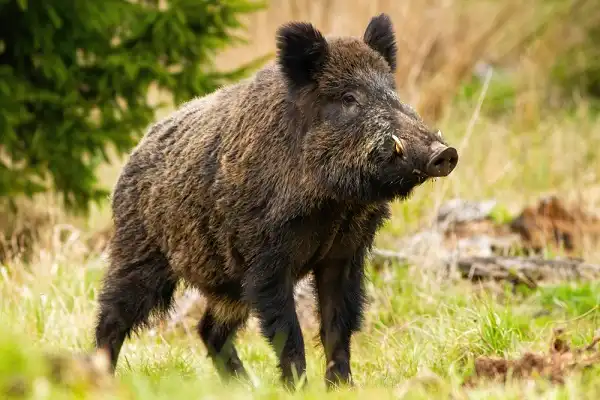The wild boar is a species of pig that has been around since prehistoric times and plays an important role in many cultures all over the world. With its unlikely combination of power, intelligence, and aggression, this remarkable mammal fascinates biologists, hunters, and those who cross paths with it in their everyday lives. In some places like Germany, it is becoming increasingly common to encounter these animals in woodlands or even urban areas; while overseas they can be found inhabiting thousands of islands and living on the fringes of society from Australia’s tropical rainforests up to Japan’s mountainsides. Whether you are interested in understanding more about this enigmatic animal or how best to manage them for conservation purposes – there’s something fascinating to learn about these far-ranging beasts! Read on as we explore the life cycle, behavior, and significance of one of our environment’s most dynamic players: the wild boar.

Wild Boar Description
The wild boar is a species of pig that, despite its name, can be found far from any wilderness. It is an impressive omnivore that can thrive in many different environments and can range considerably in size. Although larger specimens are known to exist; they possess a stocky body with short powerful legs ending in cloven hooves and a large head with pointed snout and small eyes and ears. Wild boars have thick fur that varies from white, brown, or black in color, depending on the individual and the environment. Their coloration helps them blend into their surroundings when foraging. Wild boars are highly intelligent animals, capable of learning quickly and adapting to their ever-changing environment.
Wild Boar Habitat
Wild boars inhabit a variety of environments, including forests, swamps, woodlands, and grasslands. They are highly adaptable creatures with the ability to survive in both cold and hot climates. They can typically be found in Europe, Asia, and parts of Africa as well as in parts of North America. The wild boar is an omnivore that prefers to stay near a water source such as a river or lake. They will often create wallows, which are shallow mud pits that provide an important source of moisture for them during dry periods. In some areas, they may also take shelter in caves or den sites like hollow trees during the cooler months. The wild boar is highly adaptable and can live successfully in a variety of different habitats; however, they prefer areas with ample cover such as dense vegetation or scrubland for protection from predators. Wild boars tend to live alone or in small groups called sounders; these usually consist of related females along with their young but can also include non-related members such as solitary males or bachelor groups.
Wild Boar Diet
The wild boar is an omnivorous species, which means its diet consists of both plant and animal matter. They primarily feed on roots, tubers, nuts, fruits, and insects. Wild boars have also been known to eat small mammals such as rodents and birds, as well as carrion when available. In addition to foraging for food in the wild, they are also adept at stealing crops from farms and gardens, though this behavior is usually only observable in areas where agricultural land is common. Wild boars have evolved a range of physical features that aid them in their search for food; their long snouts contain powerful senses of smell allowing them to detect edibles even under leaf litter or water. Their strong front hooves are used as digging tools to uncover root systems or grubs hidden beneath the soil while their sharp tusks are effective tools for breaking open hard-shelled fruit. In order to meet their nutritional needs, wild boars must consume a variety of different foods throughout the year; during autumn and winter they may be more likely to feed on nuts and roots while in spring and summer, they may switch to eating soft fruits or younger plant shoots.

Wild Boar Size
The wild boar is a large and impressive animal, with individuals ranging anywhere from 80 to 150 cm in length. However, larger specimens have also been recorded; the largest known wild boar ever was reportedly over 200 cm long! It has a stocky body with short powerful legs ending in cloven hooves and a large head with pointed snout and small eyes and ears. Wild boars have thick fur that varies from white, brown, or black in color, providing excellent camouflage while foraging for food in its natural habitat. Their weight also varies greatly depending on age, sex, season, and diet; adult males typically weigh between 40 to 180 kgs while females are usually smaller at 25 to 90 kgs.
Wild Boar Lifespan
Wild boars typically live for 8 to 12 years in the wild; however, some specimens have been known to reach up to 15 years of age. In captivity, they can have much longer lifespans, with some individuals living as long as 20 years or more. Their average lifespan is mainly affected by factors such as predation, disease, and other environmental conditions. Wild boars are hunted by a variety of large predators including bears, wolves, and humans; this can reduce their numbers significantly in certain areas leading to decreased lifespans overall. In addition to predation, diseases such as tuberculosis and brucellosis can also have an impact on the wild boar population; these infections can be spread quickly through contact with infected animals or contaminated food sources. Parasites like ticks or fleas can also lead to significant health issues if left untreated.
Wild Boar Behavior
Wild boars are social animals, and usually form groups called sounders which are composed of related females and their young. These sounders can also include non-related members such as solitary males or bachelor groups. Wild boars communicate with each other through grunts, squeals and barks in order to maintain coordination when foraging for food or evading predators. Overall, wild boar behavior is highly influenced by their environment; they are generally timid creatures that avoid contact with humans whenever possible but can become aggressive if threatened or cornered. They also play an important role in maintaining ecosystems by dispersing seeds throughout their habitats via droppings or simply walking through areas with ripe fruit trees. Wild boars make an invaluable contribution to human culture as well – providing both hunters and butchers with a valuable source of meat!

Wild Boar Speed
Wild boars are surprisingly fast animals, capable of reaching high speeds when running away from predators or pursuing prey. They can reach speeds upwards of 30 km/h, with some specimens even running as fast as 45 km/h in short bursts! This is partly due to their muscular legs and webbed feet, which provide excellent traction while running on a variety of terrain. In addition to their speed, wild boars have impressive agility; they are able to change direction quickly and easily when navigating dense forests or rough terrain. This is especially important for evading predators and escaping potentially dangerous situations. Their agility also allows them to climb steep hillsides or leap over obstacles that would otherwise be difficult for other animals to traverse.
Wild Boar Reproduction and Life Cycle
Wild boars reproduce year-round, with the peak of breeding season usually occurring during the fall months. During this time, adult males will compete for access to females and form mating pools that contain multiple females and one dominant male. Females typically reach sexual maturity at around two years of age and can have up to 12 piglets in a single litter after a gestation period of approximately 3 months. The newborn piglets are born blind and relatively helpless; they rely on their mother’s milk for sustenance until they are old enough to begin eating solid foods. Piglets will stay with their mother until they are weaned from her milk – usually between 3 and 4 months old. After this point, they may join another sounder or venture off on their own. Overall, wild boar reproduction and life cycle is heavily influenced by factors such as predation rates, disease prevalence, food availability, environmental conditions and population density. By providing suitable habitats with adequate resources it is possible to maintain healthy populations of wild boar even in areas where human activity is prevalent – allowing us to enjoy these magnificent animals!
Wild Boar Hunting
Wild boar hunting has been a popular pastime for centuries, and is still practiced in many parts of the world today. The practice usually involves experienced hunters pursuing wild boars with hounds- either on foot or on horseback- and then killing them with firearms or spears. In some areas, wild boar hunting can even be used to manage population size and prevent damage to crops or livestock. Wild boar hunting requires skill, determination, and knowledge of the animal’s behavior; experience in tracking is also beneficial. When pursuing a wild boar, hunters must take into consideration factors such as wind direction, terrain type, weather conditions, and vegetation cover in order to maximize their chances of success.
Furthermore, hunters should always be aware of their surroundings- especially when traversing dense forests or thick undergrowth – as wild boars are known to be quick and agile animals that can easily surprise an unsuspecting hunter! In terms of equipment for hunting wild boars, most experienced hunters will opt for a rifle or shotgun loaded with slugs or solid projectiles rather than buckshot due to the animal’s tough hide. A good pair of binoculars can also be useful in helping to spot potential targets from a distance while stalking through dense brush.

Conclusion
Wild boars are incredibly fascinating animals, possessing a multitude of unique characteristics that make them well-suited to their environment. From their impressive speed and agility to their complex reproductive cycle and hunting behaviors, wild boars demonstrate an incredible adaptability that allows them to survive in even the harshest of environments. As such, they have become beloved by many who appreciate both their beauty and strength – making them a symbol of strength and resilience for many cultures around the world.
Frequently Asked Question


